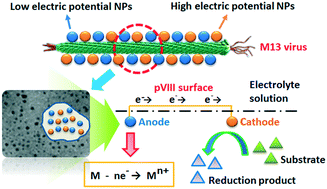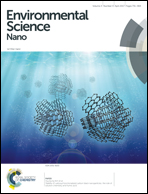Design of the nanoarray pattern Fe–Ni bi-metal nanoparticles@M13 virus for the enhanced reduction of p-chloronitrobenzene through the micro-electrolysis effect†
Abstract
Novel M13 virus-supported nanoarray patterns of bi-metal nanoparticles (NPs) were designed, synthesized and used for the enhanced reduction of p-chloronitrobenzene (p-CNB) based on the micro-electrolysis effect. Considering the potential difference between the non-noble metals Ni/Cu and Fe, FeNPs uniformly dispersed on the shaft surface of wild M13 (w-M13) were synthesized and designated as the anode and Ni/CuNPs as the cathode, with the filamentous M13 serving as the conductive “wire”. The assembled Fe–Ni@w-M13 and Fe–Cu@w-M13 micro-electrolysis systems were applied in p-CNB reduction. Compared with the single FeNPs, NiNPs and CuNPs with or without the supporting M13, both Fe–Ni@w-M13 and Fe–Cu@w-M13 exhibited an enhanced p-CNB reduction efficiency. Selecting Fe–Ni@w-M13 with the maximum p-CNB reduction ratio as the target, the reduction product of p-CNB was determined to be p-chloroaniline (p-CAN), and the oxidation product of the anode FeNPs was Fe(II). According to the optimal initial molar ratio (3 : 1) of Fe(II) : Ni(II) and TEM observation of Fe–Ni@w-M13, the quantity ratio of FeNPs to NiNPs on the surface of w-M13 was calculated to be approximately 2.4 : 1 through the pseudo crystal hypothesis. Engineered M13 (e-M13) with increased surface negative charges was further constructed, and the adsorption affinity of e-M13 toward Ni(II) was nearly 3-fold the affinity of w-M13 toward Ni(II). For Fe–Ni@e-M13, the ratio of FeNPs to NiNPs on the surface of e-M13 changed to 1.2 : 1; a higher p-CNB reduction efficiency was observed compared to Fe–Ni@w-M13, and the reduction rate constant was 1.87- and 2.68-fold those of Fe@e-M13 and FeNPs, respectively. With an optimal Fe–Ni@e-M13 dosage, 93% of p-CNB was rapidly reduced to p-CAN through the micro-electrolysis effect.


 Please wait while we load your content...
Please wait while we load your content...